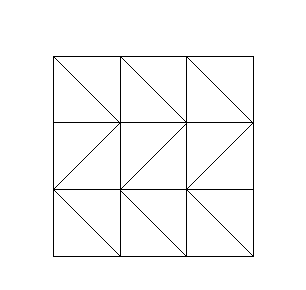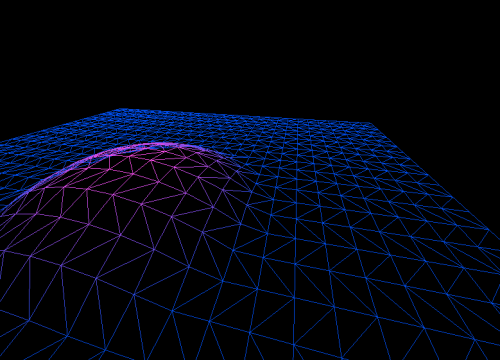Generowanie płaszczyzny z paskami trójkąta
Jaki byłby najlepszy algorytm do generowania listy wierzchołków do narysowania płaszczyzny za pomocą pasków trójkąta?
Szukam funkcji, która odbiera szerokość i wysokość płaszczyzny i zwraca tablicę zmiennoprzecinkową zawierającą poprawnie indeksowane wierzchołki.
Width reprezentuje liczbę wierzchołków w wierszu.
Wysokość przedstawia liczbę wierzchołków w kolumnie.
float* getVertices( int width, int height ) {
...
}
void render() {
glEnableClientState(GL_VERTEX_ARRAY);
glVertexPointer(3, GL_FLOAT, 0, getVertices(width,heigth));
glDrawArrays(GL_TRIANGLE_STRIP, 0, width*height);
glDisableClientState(GL_VERTEX_ARRAY);
}
4 answers
Dziękuję wam wszystkim. Zakodowałem to. Czy to prawda? A może wygenerowany pasek jest w jakiś sposób zły?
int width;
int height;
float* vertices = 0;
int* indices = 0;
int getVerticesCount( int width, int height ) {
return width * height * 3;
}
int getIndicesCount( int width, int height ) {
return (width*height) + (width-1)*(height-2);
}
float* getVertices( int width, int height ) {
if ( vertices ) return vertices;
vertices = new float[ getVerticesCount( width, height ) ];
int i = 0;
for ( int row=0; row<height; row++ ) {
for ( int col=0; col<width; col++ ) {
vertices[i++] = (float) col;
vertices[i++] = 0.0f;
vertices[i++] = (float) row;
}
}
return vertices;
}
int* getIndices( int width, int height ) {
if ( indices ) return indices;
indices = new int[ iSize ];
int i = 0;
for ( int row=0; row<height-1; row++ ) {
if ( (row&1)==0 ) { // even rows
for ( int col=0; col<width; col++ ) {
indices[i++] = col + row * width;
indices[i++] = col + (row+1) * width;
}
} else { // odd rows
for ( int col=width-1; col>0; col-- ) {
indices[i++] = col + (row+1) * width;
indices[i++] = col - 1 + + row * width;
}
}
}
if ( (mHeight&1) && mHeight>2 ) {
mpIndices[i++] = (mHeight-1) * mWidth;
}
return indices;
}
void render() {
glEnableClientState( GL_VERTEX_ARRAY );
glVertexPointer( 3, GL_FLOAT, 0, getVertices(width,height) );
glDrawElements( GL_TRIANGLE_STRIP, getIndicesCount(width,height), GL_UNSIGNED_INT, getIndices(width,height) );
glDisableClientState( GL_VERTEX_ARRAY );
}
With width = 4 and height = 4 this is what I got:

A tu modyfikuję jakąś wysokość wierzchołka:

Warning: date(): Invalid date.timezone value 'Europe/Kyiv', we selected the timezone 'UTC' for now. in /var/www/agent_stack/data/www/doraprojects.net/template/agent.layouts/content.php on line 54
2011-05-28 10:35:47
Oto jakiś kod, który to robi (nie testowany, ale przynajmniej masz pomysł):
void make_plane(int rows, int columns, float *vertices, int *indices) {
// Set up vertices
for (int r = 0; r < rows; ++r) {
for (int c = 0; c < columns; ++c) {
int index = r*columns + c;
vertices[3*index + 0] = (float) c;
vertices[3*index + 1] = (float) r;
vertices[3*index + 2] = 0.0f;
}
}
// Set up indices
int i = 0;
for (int r = 0; r < rows - 1; ++r) {
indices[i++] = r * columns;
for (int c = 0; c < columns; ++c) {
indices[i++] = r * columns + c;
indices[i++] = (r + 1) * columns + c;
}
indices[i++] = (r + 1) * columns + (columns - 1);
}
}
Pierwsza pętla ustawia tablicę wierzchołków w standardowej siatce prostokątnej. Istnieją wierzchołki R * C.
Druga pętla ustawia indeksy. Ogólnie rzecz biorąc, istnieją dwa wierzchołki na kwadrat w siatce. Każdy wierzchołek spowoduje narysowanie nowego trójkąta (z dwoma poprzednimi wierzchołkami), więc każdy kwadrat zostanie narysowany dwoma trójkątami.
Pierwszy i ostatni wierzchołek na początku i końcu każdy wiersz jest duplikowany. Oznacza to, że pomiędzy każdym rzędem znajdują się dwa trójkąty o powierzchni zerowej (Trójkąty zdegenerowane). Pozwala nam to narysować całą siatkę w jednym dużym pasku trójkąta. Technika ta nazywana jest szyciem.
Warning: date(): Invalid date.timezone value 'Europe/Kyiv', we selected the timezone 'UTC' for now. in /var/www/agent_stack/data/www/doraprojects.net/template/agent.layouts/content.php on line 54
2011-05-06 22:31:15
Żaden z powyższych kodów nie daje prawidłowego generowania siatki. Bardzo dobry artykuł o tym, jak zrobić pasek trójkątów na prostej płaszczyźnie: http://www.learnopengles.com/android-lesson-eight-an-introduction-to-index-buffer-objects-ibos/
Oto Mój kod testowy, który faktycznie przetestowany i w pełni działa:
int plane_width = 4; // amount of columns
int plane_height = 2; // amount of rows
int total_vertices = (plane_width + 1) * (plane_height + 1);
planeVert = new CIwFVec2[total_vertices];
memset(planeVert, 0, sizeof(CIwFVec2) * total_vertices);
int numIndPerRow = plane_width * 2 + 2;
int numIndDegensReq = (plane_height - 1) * 2;
int total_indices = numIndPerRow * plane_height + numIndDegensReq;
planeInd = new uint16[total_indices];
make_plane(plane_width, plane_height, planeVert, planeInd);
...
void make_plane(int width, int height, CIwFVec2 *vertices, uint16 *indices)
{
width++;
height++;
int size = sizeof(CIwFVec2);
// Set up vertices
for(int y = 0; y < height; y++)
{
int base = y * width;
for(int x = 0; x < width; x++)
{
int index = base + x;
CIwFVec2 *v = vertices + index;
v->x = (float) x;
v->y = (float) y;
Debug::PrintDebug("%d: %f, %f", index, v->x, v->y);
}
}
Debug::PrintDebug("-------------------------");
// Set up indices
int i = 0;
height--;
for(int y = 0; y < height; y++)
{
int base = y * width;
//indices[i++] = (uint16)base;
for(int x = 0; x < width; x++)
{
indices[i++] = (uint16)(base + x);
indices[i++] = (uint16)(base + width + x);
}
// add a degenerate triangle (except in a last row)
if(y < height - 1)
{
indices[i++] = (uint16)((y + 1) * width + (width - 1));
indices[i++] = (uint16)((y + 1) * width);
}
}
for(int ind=0; ind < i; ind++)
Debug::PrintDebug("%d ", indices[ind]);
}
Warning: date(): Invalid date.timezone value 'Europe/Kyiv', we selected the timezone 'UTC' for now. in /var/www/agent_stack/data/www/doraprojects.net/template/agent.layouts/content.php on line 54
2013-06-09 03:18:30
Robiłem coś podobnego i korzystając z dwóch pierwszych odpowiedzi wymyśliłem to (tested, C#, XNA)
// center x,z on origin
float offset = worldSize / 2.0f, scale = worldSize / (float)vSize;
// create local vertices
VertexPositionColor[] vertices = new VertexPositionColor[vSize * vSize];
for (uint z = 0; z < vSize; z++) {
for (uint x = 0; x < vSize; x++) {
uint index = x + (z * vSize);
vertices[index].Position = new Vector3((scale*(float)x) - offset,
heightValue,
(scale*(float)z) - offset);
vertices[index].Color = Color.White;
}
}
// create local indices
var indices = new System.Collections.Generic.List<IndexType>();
for (int z = 0; z < vSize - 1; z++) {
// degenerate index on non-first row
if (z != 0) indices.Add((IndexType)(z * vSize));
// main strip
for (int x = 0; x < vSize; x++) {
indices.Add((IndexType)(z * vSize + x));
indices.Add((IndexType)((z + 1) * vSize + x));
}
// degenerate index on non-last row
if (z != (vSize-2)) indices.Add((IndexType)((z + 1) * vSize + (vSize - 1)));
}
Jest to łatwe do konwersji do c++, po prostu stwórz indices std:: vector.
Godnymi uwagi cechami mojego rozwiązania są: a) nie trzeba zmieniać kolejności nawijania na podst. - dodanie dwóch punktów tworzy dwa zdegenerowane Trójkąty, więc kolejność jest poprawna dla następnego podst. b) należy warunkowo dodać pierwszy i ostatni wierzchołek trójkąta dg.
Warning: date(): Invalid date.timezone value 'Europe/Kyiv', we selected the timezone 'UTC' for now. in /var/www/agent_stack/data/www/doraprojects.net/template/agent.layouts/content.php on line 54
2011-09-12 18:27:45